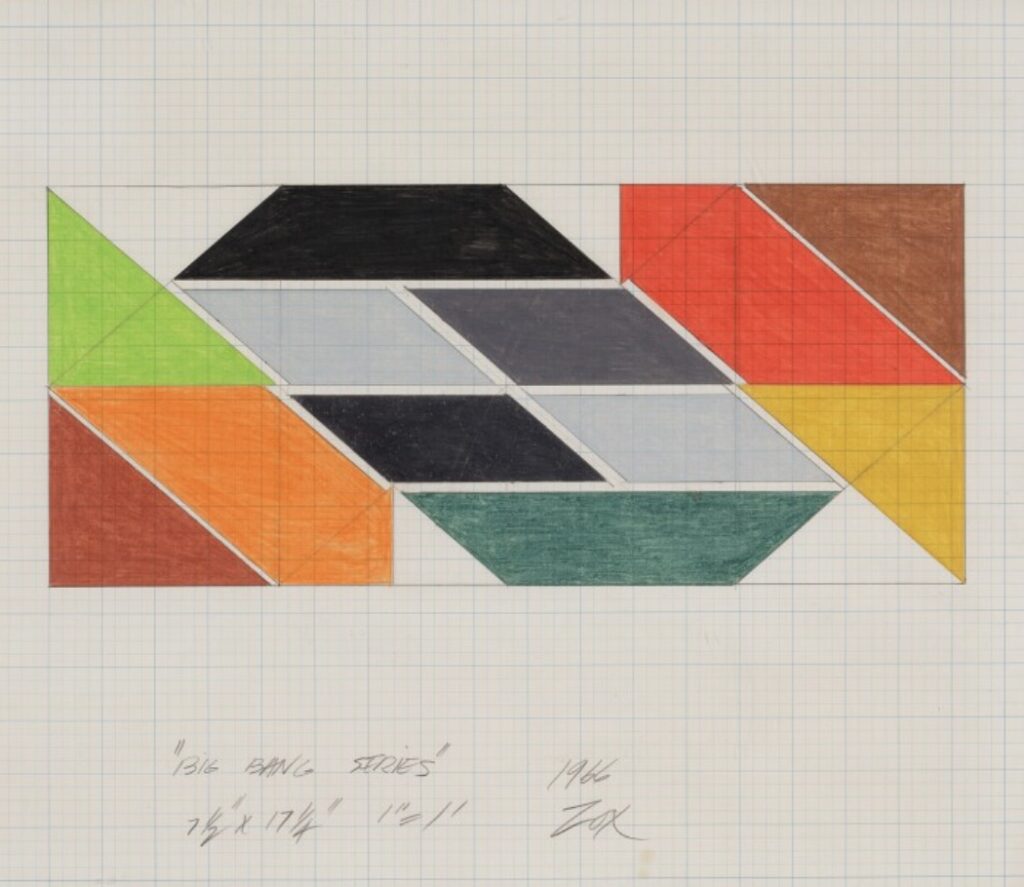Larry Zox, a key figure in the American abstract art movement of the 1960s and 1970s, created a striking body of work that continues to captivate audiences today. One of his most prominent pieces, “Big Bang Theory”, stands as a testament to his mastery of color, form, and movement within the realm of geometric abstraction. Known for his bold use of color and his dynamic, hard-edged compositions, Zox’s work plays with the viewer’s perception of space and form. “Big Bang Theory” is no exception, offering a complex and captivating visual experience that reflects his innovative approach to painting.
This piece, like many of Zox’s works, is part of the broader Color Field and Minimalist movements that emerged during the 1960s. However, Zox’s unique contribution to this period of art history lies in his ability to blend the precision of geometric abstraction with a sense of dynamism and tension. In “Big Bang Theory”, Zox creates a visual explosion that speaks to the ideas of movement, expansion, and energy, themes that resonate with the scientific concept it shares a name with. In this essay, we will explore the formal elements of “Big Bang Theory”, its conceptual underpinnings, and its significance within Zox’s broader body of work.
Composition and Structure: The Power of Geometry
At first glance, “Big Bang Theory” immediately captures attention with its sharp, geometric shapes and its striking interplay of color. Zox uses angular forms, often juxtaposing triangles and trapezoids that intersect and overlap in ways that create both harmony and tension within the composition. These forms seem to burst outward from a central point, evoking the idea of an explosion—a clear reference to the scientific “big bang” that suggests the universe’s rapid expansion from a single point of origin.
The painting’s geometric forms are carefully arranged, yet they do not feel static. Zox’s skill lies in his ability to balance these hard-edged shapes in such a way that they appear to be in motion, as though the viewer is witnessing an instant frozen in time. This sense of movement is enhanced by the way Zox manipulates the edges of his shapes, often allowing them to extend beyond the boundaries of the canvas. This gives the impression that the explosion continues beyond the frame, inviting the viewer to imagine the painting as part of a much larger, infinite universe.
Zox’s use of symmetry, while present, is not rigid. There is a deliberate imbalance in the way the shapes are distributed across the canvas, which adds to the dynamic quality of the piece. This subtle asymmetry creates a visual tension that is central to the work’s energy. The viewer’s eye is constantly drawn from one shape to another, unable to rest in any one place for long, as the composition seems to pulse with life.
Color: A Vibrant Explosion
The colors in “Big Bang Theory” are as important as the geometric forms in conveying the work’s sense of movement and energy. Zox was known for his bold use of color, often employing high-contrast combinations that enhance the optical intensity of his compositions. In “Big Bang Theory”, Zox uses a limited but striking color palette, with bright primary colors—reds, blues, and yellows—set against deep blacks and crisp whites. These colors are applied in broad, flat areas, without any shading or gradation, further emphasizing the geometric quality of the piece.
The juxtaposition of warm and cool tones adds to the sense of expansion and contraction within the painting. The reds and yellows, often positioned near the center of the composition, seem to radiate outward, while the cooler blues and blacks serve to ground the piece, pulling the viewer’s eye back into the canvas. This careful balance of warm and cool colors not only enhances the visual impact of the piece but also mirrors the scientific concept of the Big Bang, in which matter and energy rapidly expand and cool.
Zox’s use of color is not merely decorative; it plays a critical role in the viewer’s experience of space and depth within the painting. Despite the flatness of the canvas, the interplay of colors creates the illusion of layers and planes, as though the geometric forms are shifting in and out of focus. This adds another layer of complexity to the work, as the viewer’s perception of space is constantly being challenged and redefined.
Conceptual Underpinnings: Art and Science Intersect
While “Big Bang Theory” is first and foremost an exploration of form, color, and composition, its title suggests deeper conceptual ties to the scientific understanding of the universe’s origins. The Big Bang Theory, in cosmology, describes the rapid expansion of the universe from a hot, dense point approximately 13.8 billion years ago. Zox’s painting captures this sense of explosive energy and rapid movement, translating a scientific concept into visual form.
This intersection of art and science is particularly significant in the context of the 1960s and 1970s, a period marked by rapid technological and scientific advancements. Artists like Zox were deeply engaged with the changing world around them, and their work often reflected the tensions and possibilities of this new era. In “Big Bang Theory”, Zox seems to be grappling with the idea of creation and destruction, of order emerging from chaos. The painting’s structured geometric forms suggest a sense of control, yet the overall composition conveys a feeling of unpredictability and expansion, mirroring the duality present in both the scientific theory and the human experience of a rapidly changing world.
Zox’s Legacy and the Significance of “Big Bang Theory”
“Big Bang Theory” occupies a central place in Larry Zox’s oeuvre, showcasing his ability to push the boundaries of geometric abstraction while maintaining a strong sense of visual coherence. Throughout his career, Zox was interested in the tension between precision and spontaneity, between order and chaos. In this painting, he masterfully navigates these opposites, creating a work that feels both controlled and explosive.
Zox’s work, including “Big Bang Theory”, is often associated with the broader Color Field movement, yet he stands apart from many of his contemporaries due to his emphasis on geometry and movement. While artists like Mark Rothko and Barnett Newman explored the emotional resonance of color through large, flat planes, Zox focused on the interplay between color and shape, creating compositions that are not just about feeling but also about structure and space.
“Big Bang Theory” remains relevant today, both for its formal innovation and for the way it reflects the cultural and intellectual currents of its time. In an era when the boundaries between art and science are increasingly blurred, Zox’s work invites viewers to consider the ways in which abstract forms can communicate complex ideas about the universe and our place within it.
A Dynamic Fusion of Form and Concept
Larry Zox’s “Big Bang Theory” is a masterful example of geometric abstraction that transcends its formal elements to engage with larger philosophical and scientific questions. Through his bold use of color, dynamic composition, and the careful arrangement of geometric forms, Zox creates a work that feels both expansive and contained, both chaotic and controlled. The painting captures the essence of the Big Bang—the moment when everything began—while also reflecting the artist’s deep engagement with the visual possibilities of abstraction.
“Big Bang Theory” continues to resonate with audiences today, not only for its aesthetic appeal but also for its conceptual richness. In Zox’s hands, geometric abstraction becomes a powerful tool for exploring the mysteries of creation, movement, and time. As viewers, we are invited to lose ourselves in the painting’s intricate interplay of shapes and colors, experiencing firsthand the energy and tension that make this work such a vital part of Zox’s legacy.
No comments yet.








